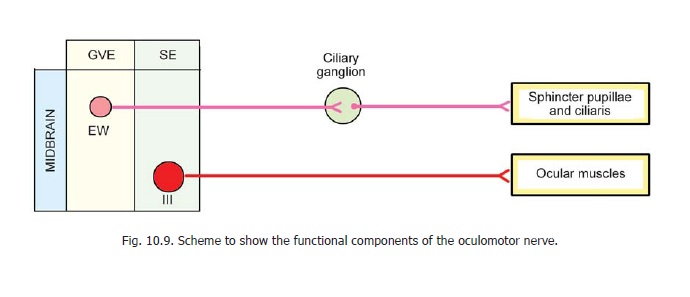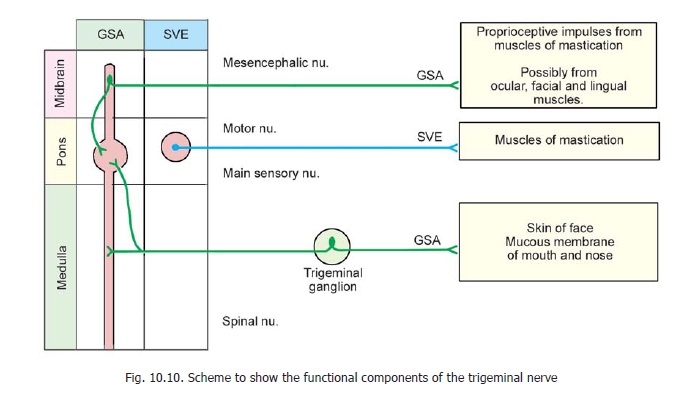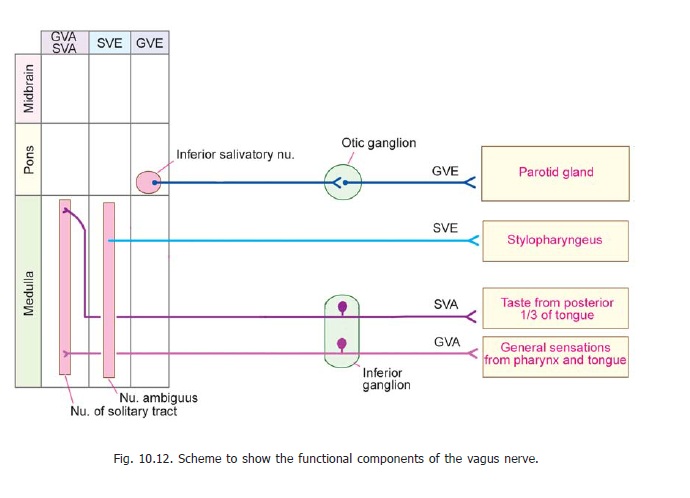Chapter: Human Neuroanatomy(Fundamental and Clinical): Cranial Nerve Nuclei
Functional Components of Individual Cranial Nerves
Functional Components of Individual Cranial Nerves
Having considered the cranial nerve nuclei and their connections it is now possible to work out the functional components of each cranial nerve.
Olfactory nerve
This is the nerve of smell. As the olfactory mucosa is derived from ectoderm (of the nasal placodes) this nerve is classified asspecial somatic afferent (along with vision and hearing). However, in view of the close relationship between the sensations of smell and taste, some authorities classify this nerve as special visceral afferent.
Optic nerve
This is the nerve of vision. Its fibres are regarded as special somatic afferent. From the point of view of its structure and development this nerve is to be regarded as a tract of the brain rather than as a peripheral nerve.
Oculomotor nerve
This nerve has the following components (Fig. 10.9).
a. Somatic efferent fibres arising in the oculomotor nucleus supply all extrinsic muscles of theeyeball except the lateral rectus and the superior oblique.
b. General visceral efferent fibres (preganglionic) arise in the Edinger-Westphal nucleus andterminate in the ciliary ganglion. Postganglionic fibres arising in this ganglion supply the sphincter pupillae and the ciliaris muscle.

Trochlear nerve
This nerve is made up of somatic efferent fibres arising in the trochlear nucleus and supplying the superior oblique muscle of the eyeball.
Trigeminal nerve
This nerve contains the following components (Fig. 10.10).
a. Special visceral efferent fibres arise from the motor nucleus of the nerve and supply the muscles of mastication.
b. General somatic afferent fibres of the nerve are peripheral processes of unipolar neurons in the trigeminal ganglion. They carry exteroceptive sensations from the skin of the face, and the mucous membrane of the mouth and nose. The central processes of the neurons in the ganglion constitute the sensory root of the nerve. They terminate in the main sensory nucleus and in the spinal nucleus of the nerve.

Another group of general somatic afferent neurons carry proprioceptive impulses from the muscles of mastication (and possibly from ocular, facial and lingual muscles). These fibres are believed to be peripheral processes of unipolar neurons located in the mesencephalic nucleus of this nerve.
Abducent nerve
This nerve consists of somatic efferent fibres that arise from the abducent nucleus and supply the lateral rectus muscle of the eyeball.
Facial nerve
The components of this nerve are as follows (Fig. 10.11).

a. Special visceral efferent fibres begin from the motor nucleus and supply the various muscles to which the nerve is distributed.
b. General visceral efferent fibres (preganglionic) arise in the superior salivary nucleus. They relay in the submandibular ganglion from which postganglionic fibres arise to supply the submandibular and sublingual salivary glands.The facial nerve also carries general visceral efferent fibres for the lacrimal gland. The preganglionic neurons concerned are said to be located near the salivary nuclei. Their axons terminate in the pterygopalatine ganglion, from which postganglionic fibres arise to supply the gland.
c. Special visceral afferent fibres are peripheral processes of cells in the geniculate ganglion of the nerve. They supply taste buds in the anterior two-thirds of the tongue (and some in the soft palate). The central processes of the ganglion cells carry these sensations to the upper part of the nucleus of the solitary tract.
d. General somatic afferent fibres are also peripheral processes of some cells of the geniculate ganglion. They innervate a part of the skin of the external ear. The central processes of these cells end in the spinal nucleus of the trigeminal nerve.
Vestibulocochlear nerve.
Both the cochlear and vestibular divisions of this nerve are made up of special somatic afferent fibres. The fibres of the cochlear nerve are central processes of bipolar cells in the spiral ganglion.The peripheral processes of these neurons supply the organ of Corti. The fibres of the vestibular nerve are central processes of bipolar neurons in the vestibular ganglion. The peripheral processes of these neurons innervate the semicircular ducts, the utricle and the saccule of the internal ear.
In the past this nerve has also been called the auditory or stato-acoustic nerve.
Glossopharyngeal nerve
The components of this nerve are as follows.
a. Special visceral efferent fibres arise in the nucleus ambiguus and supply the stylopharyngeus muscle.
b. General visceral efferent fibres (preganglionic) begin from the inferior salivary nucleus and travel to the otic ganglion. Postganglionic fibres arising in the ganglion supply the parotid gland.
c. General visceral afferent fibres are peripheral processes of neurons in the inferior ganglion of the nerve. They carry general sensations (touch, pain, temperature) from the pharynx and the posterior part of the tongue to the ganglion. They also carry inputs from the carotid sinus and carotid body. Central processes of the neurons carry these sensations to the nucleus of the solitary tract. Some fibres from the carotid sinus and body reach the paramedian reticular formation of the medulla.
d. Special visceral afferent fibres are also peripheral processes of neurons in the inferior ganglion. They carry sensations of taste from the posterior one-third of the tongue to the ganglion. The central processes carry these sensations to the nucleus of the solitary tract.
Vagus nerve
The components of this nerve are as follows (Fig. 10.12).
a. Special visceral efferent fibres are processes of neurons in the nucleus ambiguus and supply the muscles of the pharynx and larynx.
b. General visceral efferent fibres arise in the dorsal (motor) nucleus of the vagus. These are preganglionic parasympathetic fibres. They are distributed to thoracic and abdominal viscera. The postganglionic neurons concerned are situated in ganglia close to or within the walls of the viscera supplied.

c. General visceral afferent fibres are peripheral processes of neurons located in the inferior ganglion of the nerve. They bring sensations from the pharynx, larynx, trachea, and oesophagus; and from abdominal and thoracic viscera. These are conveyed by central processes of the ganglion cells to the nucleus of the solitary tract. According to some authorities some of these fibres terminate in the dorsal nucleus of the vagus.
d. Special visceral afferent fibres are also peripheral processes of neurons in the inferior ganglion. They carry sensations of taste from the posteriormost part of the tongue and from the epiglottis. The central processes of the neurons concerned terminate in the upper part of the nucleus of the solitary tract.
e. General somatic afferent fibres are peripheral processes of neurons in the superior ganglion and are distributed to the skin of the external ear. The central processes of the ganglion cells terminate in relation to the spinal nucleus of the trigeminal nerve.
Accessory nerve
This nerve consists, predominantly, of special visceral efferent fibres which arise from:
a. the nucleus ambiguus to supply striated muscle of the pharynx, the soft palate, and the larynx (along with the vagus); and
b. the lateral part of the anterior grey column of the upper five or six cervical segments of the spinal cord, to supply the trapezius and sternocleidomastoid muscles.
Hypoglossal nerve
This nerve is made up of the following components.
a. Somatic efferent fibres are processes of neurons in the hypoglossal nucleus. They supply the muscles of the tongue.
b. General somatic afferent fibres carry proprioceptive impulses from muscles of the tongue. The location of the cells of origin of these fibres is uncertain. In the embryo a small ganglion is present in relation to the nerve, but cannot be identified in the adult. Some unipolar cells can, however, be identified on the roots of the hypoglossal nerve.
Groups of neurons innervating individual muscles of the tongue can be recognised in the hypoglossal nucleus.
The functional components of cranial nerves enumerated above are those on which there is wide agreement. The presence of some additional components is described by some workers. The oculomotor, trochlear and abducent nerves may carry proprioceptive impulses (GSA) from ocular muscles; and the facial nerve from the muscles of the face, but as stated above most authorities believe that these impulses are carried by the trigeminal nerve. Some workers describe a GVE component in the accessory nerve (for supply of thoracic and abdominal viscera) and a GSA component (for skin of the ear, and for proprioceptive impulses from the stylopharyngeus) in the glossopharyngeal nerve.
Related Topics